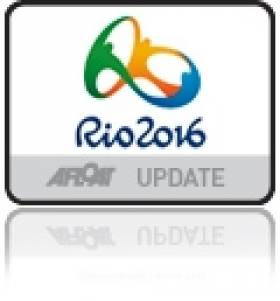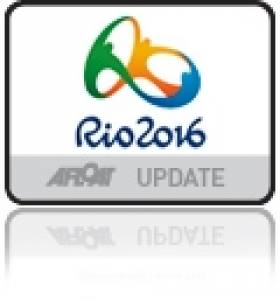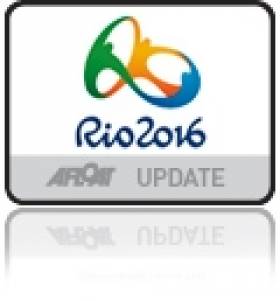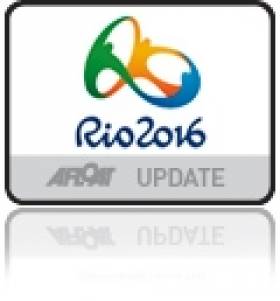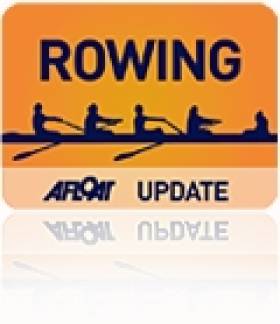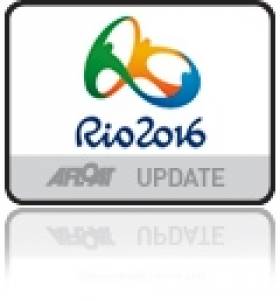Displaying items by tag: Olympic
Irish Laser Sailors Perform Well in Hvar Europa Cup, Croatia
#youthsailing – The National Yacht Club's (NYC) Laser Rio trialist Finn Lynch finished third overall at last week's Europa Cup in Hvar Croatia. Schull's Fionn Lyden was sixth in the 19–boat fleet and Ireland's 2014 ISAF youth silver medallist Seafra Guilfoyle completed his youth sailing career second in the under –19 division.
ISAF Sailing World Cup Final Off To A Spectacular Start
The opening day of racing at the inaugural ISAF Sailing World Cup Final in Abu Dhabi, United Arab Emirates has been described as spectacular, fantastic and perfect.
Smiles were present before racing at the Abu Dhabi Sailing & Yacht Club, on the waters off of the Corniche and around Lulu Island and back ashore upon the conclusion of racing.
Although three Irish sailors were invited to the Cup they are not competing due to budget and time constraints.
A north westerly breeze that ranged between 9-14 knots greeted the sailors across the four race tracks. The outside courses saw big waves to add some spice to the sailors lives whilst the flat water on the inside Corniche course tested the sailors all round abilities.
Racing for the 270 sailors from 38 nations across the ten Olympic and open kiteboarding fleet commenced at 12:00 local time and wrapped up with a full complement of races in the Olympic events.
Finn
Slovenia's Vasilij Zbogar was dominant in Abu Dhabi's conditions, picking up a pair of race wins in the 19-boat Finn fleet.
After racing, ashore at the Abu Dhabi Sailing & Yacht, the Slovenian was visibly pleased yet shocked with his regatta opening, "I am a bit surprised with the two first places. It's much better than I thought I would start. The conditions were perfect for my technique and weight and my boat speed was extremely good. The main issue was that I got a yellow flag in the first race which was a bit annoying but I still finished first."
Zbogar's victories came by different margins. A close encounter with Jake Lilley (AUS) in the opening race saw him take the victory by a narrow two seconds. He ramped it up in the second race, taking the gun by 30 seconds over Pieter Jan Postma (NED) and Zbogar wants to continue in the same way on the second day, "I hope we will have the same conditions. I will try to keep this first place until the end but I know it is going to be very hard. Today it was really nice sailing conditions and I'm looking forward to the next few days."
Abu Dhabi is a new venue for the Slovenian and he has taken to it well, not only the sailing side but offshore as well, "Until now, Abu Dhabi has been a big surprise for me. Everybody was a bit sceptical at first, maybe the venue and the sailing conditions weren't right but here we are and people are extremely helpful, everything is extremely well organised and the sailing is spectacular.
"I think all the sailors are really happy and they all see it's a big step forward in Olympic classes."
Lilley trails the Slovenia by five points in second place whilst Croatia's Ivan Kljakovic Gaspic occupies third overall, a point behind Lilley.
49erFX
New Zealand's Alex Maloney and Molly Meech started the ISAF Sailing World Cup Final with a bang by taking the opening race victory in the 17-boat 49erFX fleet.
The pair picked up a second victory in the third race of the day but a sandwiched tenth tarnishes their good start. Nonetheless the Kiwis had some great racing as Maloney explained, "It was beautiful conditions out there with a nice Abu Dhabi breeze and really nice waves. We were on Course C in front of the Emirates Palace and it was pretty nice out there. The first and last race we had 8-10 knots and it dropped down and got a bit interesting, it's really nice racing out there.
"We were pretty disappointing with our performance at the Worlds but we had a good break and have had some good preparation for Abu Dhabi. We were in Rio for three weeks and we're feeling a lot more confident again and a lot more focused."
Whilst the Kiwis lead, it's the Italian pairing of Giulia Conti and Francesca Clapcich who were the masters of consistency as they notched up a race win and a pair of seconds. They sit second overall by nature of the Kiwis discarding their tenth and Conti's face was full of smiles after racing, "It was perfect, perfect conditions. There were 10-14 knots with good waves and we enjoyed it a lot. We had good results and that's why we enjoyed it a lot.
"We felt very comfortable with the boat. It's good to have a brand new boat as we used to sail with a pretty old one so there are a lot of differences in performance. It's just perfect to escape from winter and to be here, we love it."
Conti was also full of praise for everything she has seen thus far at the ISAF Sailing World Cup Final in Abu Dhabi, "We are staying in such a beautiful hotel and the people here are just so gentle and kind. They're so curious about sailing as well. The venue is just perfect. There is plenty of space so we can move around without having the problem of touching other boats. The weather is warm and there is a huge mall right here, it has everything. I would stay here the whole winter."
Sweden's Lisa Ericson and Hanna Klinga complete the podium after the opening day but it's still early stages in the competition with six fleet races to follow ahead of the Medal Race.
49er
Captain America and Superman's Polish alias' Tomasz Januszewski and Jacek Nowak have swooped in to Abu Dhabi to take the 49er lead on the opening day of the ISAF Sailing World Cup Final.
The pair picked up two races wins and a 13th, discarding the latter to top the bill in the 18-boat 49er fleet. They lead Great Britain's Dylan Fletcher and Alain Sign by a single point, "It's great to be here and race here with the best of the best," commented Nowak. "We were on Course D so we were inside the bay and the wind was inshore so there was a lot of shifts and gusts. It was good to have great speed and to be able to read the shifty conditions. All the teams were very close to each other throughout the races."
The Polish competitors are instantly recognisable on the race track with their superhero outfits and Januszewski explained the origin of their tops, "We are co-operating with under armour, so when the t-shirts went on sale our friend gave us a couple of them.
"He asked who we would like to be and I was just like, stop there, 'I want to be Captain America', because I love that superhero and Jack loves Superman.
"After we first wore them everybody has called us Superman and Captain America," continued Januszewski with a beaming smile, "They're defending someone's honour and ambitions so we like those and they're really friendly, they're not bad guys.
"It's a good way to show potential sponsors what we can do and how many opportunities we can give them."
The racing on the 49er race course was exceptionally close with little separation of the fleet across three races. Fletcher and Sign picked up the first race victory before finishing second behind the Polish sailors in the second. The Brits did not sail the third race due to an equipment issue as the Polish sailors swooped through to take their second race win and the lead.
Januszewski and Nowak are in a good spot to progress with six fleet races and a Medal Race remaining and will be looking to draw on their super strength from within, "With any power you can achieve anything," said Januszewski, "but if we were to have a power I think we'll take super speed."
Women's RS:X
Great Britain's Bryony Shaw stole the show in the Women's RS:X taking three consecutive race victories to hold a steady lead over her rivals at the ISAF Sailing World Cup Final in Abu Dhabi, United Arab Emirates.
The British racer, who won bronze at the Beijing 2008 Olympic Sailing Competition, was in exceptional form, mastering the conditions and ruling the waves on one of the outside course areas.
"We were out on Course C today so we had quite a bit of swell and waves," said Shaw. "The wind was between 10 and 13 knots and I was pleased to be sailing fast."
Shaw proved to be a class above the rest as she read the conditions perfectly to lead at the first mark in all of the races as she explained, "I got a good start in the first race but not such a good start in the second race. The wind had just started flicking to the right so I made a gain from going to the right in that race. The first two races I rounded first and was able to extend my lead.
"In the last race we had lighter winds. I had a great start by the committee boat and really good height and speed and managed to round first again. It was quite a physical race that one. I kept it quite simple and stayed between my competitors and the mark and managed to win that third race. It was a really good day."
With 270 sailors from 38 nations competing in Abu Dhabi, the British sailor is just one of many competitors who are revelling in the Emirati capital. With a blend of old traditions in a modern metropolis there is plenty for the sailors to learn and enjoy, both on and off the water, "I've tried to immerse myself in the culture and we've been going out for dinners and the people here seem really friendly," added Shaw. "The conditions today were fantastic. To be sailing out there in board shorts and for it to be warm, sunny and to be sailing in planing conditions is the best for windsurfing. I've had a great time here so far. It's been a short regatta for them to try and set up but it's going well."
China's Qiaoshan Weng is second overall following a third, second and a discarded 14th. Charline Picon (FRA), 2014 Women's RS:X World Champion, is third overall after an up and down day that included a second, a fourth and a discarded 14th place finish.
Men's RS:X
Youngsters Pawel Tarnowski (POL) and Louis Giard (FRA) are showing their experienced counterparts how to race in Abu Dhabi as they top the bill in the Men's RS:X fleet.
Tarnowski, 20-years-old, stormed into the lead following an exceptional day on the water. He amassed two race wins and a third and holds a two point advantage over Giard, 21-years-old, who took a pair of seconds and a third.
The youngsters lead their more experienced rivals but only time will tell if they are able to continue it through for a podium finish on Sunday 30 November.
Laser Radial
Tuula Tenkanen (FIN) is in control in the 18-boat Laser Radial pack. She picked up a fourth and a first to hold a five point advantage over Alison Young (GBR) going into the second day of competition.
Young has had some time away from the boat throughout 2014 and is happy to be back, competing against the best Laser Radial sailors in Abu Dhabi, "It's been great fun racing against all the great sailors that are here this week. I'm here this week to learn as much as possible. There are 18 great sailors here so every race is really tight and every point counts.
"It was such tight racing today out on the water with boats crossing the line in packs and I expect that will be a similar story for the rest of the regatta."
London 2012 bronze medallist Evi Van Acker (BEL) completes the podium at the early stage of the event.
Laser
World #1 Tom Burton (AUS) showed his worth in Abu Dhabi by grasping the Laser lead after the opening day of racing. Burton was strong on the race track and took a fifth and a bullet and was pleased after racing, "It was pretty solid day all around," commented Burton, "The top guys are all here and with the 20 boat fleet you can't afford to have a bad race because the guys that will win this regatta, won't do that so you won't have a chance to catch up."
Pavlos Kontides (CYP) took the first race win but an 11th in the second race relegated him down to fifth overall.
ISAF Sailing World Cup Qingdao gold medallist Tonci Stipanovic (CRO) is tied on points with Burton in second whilst Nick Thompson (GBR) occupies third.
Men's and Women's 470
It was business as usual for World Champions Mat Belcher and Will Ryan (AUS) in the Men's 470. The pair strolled into pole position following a 2-4 scoreline. Greece's Panagiotis Mantis and Pavlos Kagialis are second on eight points with Austria's David Bargehr and Lukas Mahr in third on ten points.
The day's race wins went the way of Stu McNay and David Hughes (USA) who are sixth overall and fifth placed Matthias Schmid and Florian Florian Reichsteaedter (AUT).
China's Shasha Chen and Haiyan Gao and Austria's Lara Vadlau and Jolanta Ogar shared places one and two in the Women's 470 and are tied atop of the 11-boat fleet on three points.
Very little separated the two teams on the opening day and they will do battle once again on the second day with two more races scheduled.
America's Anne Haeger and Briana Provancha are third overall on 10 points, seven off the leading duo but there is plenty of time for change.
Nacra 17
It's an all French top three in the Nacra 17 with World Champions Billy Besson and Marie Riou leading the way. Besson and Riou are seemingly unstoppable in the Nacra 17 and amassed a steady scoreline that featured two seconds and a race win.
Their compatriots Audrey Ogereau and Matthieu Vandame follow in second with Moana Vaireaux and Manon Audinet in third.
Matias Buhler and Nathalie Brugger (SUI), Vittorio Bissaro and Silvia Sicouri (ITA) and Thomas Zajac and Tanja Frank (AUT) are hot on the French teams heals, tied on nine points.
Open Kiteboarding
Riccardo Leccese (ITA) came out on top on the opening day of kiteboarding after he picked up a pair of bullets. He heads into the next stage as top seed. 2014 World Champion Maxime Nocher (FRA), European and Open Asian Champion Oliver Bridge (GBR) and 2013 World Champion Florian Gruber (GER) follow in places 2-4.
The 20 competitors will be divided up for Stage 2 heats on Friday and Saturday based on their seeding from Stage 1. The top ten boats will then progress to the medal stage.
Two semi-finals will be held with five racers in each. Places 1 and 2 will carry forward ten points, 3 and 4 seven points, 5 and 6 five points, 7 and 8 four points and 9 and 10 three points. Two races in each semi-final will follow with the top two placed sailors in each heading to the final.
From there, it's a four way single race shoot out for the podium spots.
Racing across the fleets is scheduled to commence at 12:00 local time on Friday 28 November.
Results are available here
#sailingdrive – A trio of key speakers will address a global audience to demonstrate how inspiration and innovation can increase participation and generate business success. Olympic Gold Medallist Iain Percy OBE will welcome delegates from around the world to the International Sailing Summit (ISS) on 17 November 2014 and record-breaking quadriplegic sailor Hilary Lister and Rod Carr, Chairman of UK Sport will headline the Gala Dinner.
These key figures in the sailing world compliment an already exciting line up of international speakers at the worldwide industry forum. Recognised for driving positive change and promoting sailing on a global scale the programme centres on the theme 'Waking up the sailing industry – how sailing needs to modernise, diversify and develop to attract and retain participants'. Highlights include Spinsheet Magazine's advice on changing your game plan to welcome diverse customers, using British Cycling as a case study to grow participation, Oman Sail's view on empowering women through sports and using cost effective technology to improve participation with examples from Sail Racer.
Organised by British Sailing, a group association of the British Marine Federation (BMF), the event is expected to attract some 150 delegates representing all aspects of their sailing sector from every corner of the globe. It is the perfect event for companies who share the ultimate goal of increasing participation and bringing more business in the future. The summit takes place in Amsterdam the day before the world-renowned Marine Equipment Trade Show (METS).
Iain Percy OBE, Olympic sailor and Team Manager for Artemis Racing, said: "The recent America's Cup was a real breakthrough in making sailing mainstream; it was the first time I'd heard lots of my non-sailing friends saying they were staying up to watch the racing and that sentiment was echoed around the world. The sport was shown in such a great light. As an industry we now have to build on that excitement to continue to attract newcomers and grow the sport. Getting more people enjoying time on the water ensures the whole sector benefits."
Steve Norbury from Selden Masts added: "The sailing industry is very dynamic and presents many opportunities. I am keen to always lead Selden forwards in terms of technology, service and performance and look for the best way to gain best practice advice and networking opportunities. The International Sailing Summit is one of the best ways to achieve this and the theme for this year is exactly what the industry needs to face. I can't wait to listen to this year's speakers."
A Different Approach to Olympic Sailing Nominations: No Trials, Just Pure Selection?
#roadtorio2016 – After Ireland secured three Olympic berths for Rio in Santander, the Irish Sailing Association (ISA) has yet to publish its own selection criteria on how Irish sailors might contest these places. According to David O'Brien in last Frday's Irish Times Sailing Column this will 'hopefully' will be available by the end of October but that's not quick enough for Water Rat.
The Rat has drawn up his own alternative Irish criteria for Rio with the basic idea that any sailor who goes to the games must contribute to medal chances – either now or in the future.
Water Rat maintains the important thing is to build for the future and the big debate is how you decide between upward trending rising talent and what some insiders are calling 'static incumbents'. The Rat concludes that given the notoriously fickle conditions that are forecast for Brazil, it is now time to think 'outside the box' and proposes no trials at all – just pure selection:
Rio 2016 Olympic Sailing Team Selection Criteria by Water Rat
In making the selection the selectors will have as their primary guiding factor the maximisation of Irish medal performances in 2016 and subsequent games.
To be eligible for selection, all sailors must be country qualified and must, by January 1st 2015, sign a binding contract with the Irish Sailing Association which, inter alia, establishes the conditions pertaining to training, competition, lifestyle, sponsorship, funding, behaviour and the appeal mechanism in the event of contract disputes.
Sailors, whose performance qualified Ireland at the World Championships in 2014, are not guaranteed selection.
If country qualification has not been achieved at or before the Class world Championships in 2015, then sailors competing in that class will not be considered for selection.
The following points will be taken into consideration:
1. Improving results at major European or International Events, including World and Continental Championships, World Cup events and Eurosaf Events.
2. The trend in results at these events.
3. The potential for results at future games.
Should two or more sailors/team in one or more classes achieve a suitably high standard of results, then a trial may be held. Such a trial will use a major event or events to determine the favoured sailor/team.
In classes where only one Irish Sailor/team has displayed a satisfactory standard early confirmation of selection may be made.
Rio 2016 Olympic Sailing Regatta Qualification System
#rio – The qualification system for the Olympic Games of the XXXI Olympiad – RIO 2016 is published by the International Sailing Federation (ISAF) and available to download here as a five page pdf document below.
Irish Olympic Sailing Team Eye Rio Places at ISAF Worlds in Santander
#olympicsailing – 1,250 sailors in over 900 boats from 84 nations will begin competing at the ISAF Sailing World Championships in Spain tomorrow. 50% of Rio 2016 Olympic places will be up for grabs at the regatta as well as numerous World Titles.
The ISAF Worlds, hosted in Santander in northern Spain, is the event every sailor has been aiming to peak at since the London 2012 Olympic Games and the competition will be fierce. Among the sailing talent will be eight Irish sailors, competing across five different classes.
This event will be the first opportunity for Irish sailors to qualify Ireland for the 2016 Games in the following classes:
Laser Radial – Annalise Murphy
Laser Standard – James Espey
49er – Ryan Seaton & Matt McGovern
Laser Standard – Finn Lynch
49erFX – Andrea Brewster & Saskia Tidey)
Finn – Ross Hamilton
First to compete will be the Laser classes. This will include Annalise Murphy in the Laser Radial and James Espey and Finn Lynch both in the Laser Standard. Racing for these classes will begin tomorrow and continue until the top 10 boats qualify for the Medal Races on Thursday the 18th of September. The top 19 nations will qualify their country for the Games in the Radial fleet and the top 23 will qualify in the men's Standard fleet.
The 49er, 49erFX and Finn classes will begin racing on Monday the 15th of September, concluding the regatta with their Medal Races on Sunday the 21st of September. Ireland will have three teams competing in these classes including duos Ryan Seaton & Matt McGovern and Andrea Brewster & Saskia Tidey. Both of these teams must finish in the top 10 nations to qualify for the Games in two years' time.
German Sailing Team Form Technology Partnership with Australian & Japanese National Sailing Teams
#rio – Three national teams are working together to develop some of the most advanced race data in the sailing world writes Andy Rice.
In preparation for the Olympic qualification regatta in Santander this September, the ISAF Sailing World Championships, the Australian and Japanese teams are working closely with Audi Sailing Team Germany to create a comprehensive wind and current model. Advanced solutions developed by the German team together with its technology partner SAP serve as the foundation for this process.
This summer marks the beginning of qualifications for the 2016 Olympic Games in Rio for the sailors. After the Football World Cup, Rio de Janeiro will welcome 400 sailors for the Olympic test regatta in Guanabara Bay. Shortly afterwards the first qualification regatta for Rio 2016 will start in Santander, Spain.
Complex tidal patterns present a unique challenge for the sailors and can make a big difference to the outcome of a race. While the international press is only talking about the poor water quality in Rio, teams are not only measuring the level of pollution but also the speed at which the water is moving.
The German team is also busy collecting data in Santander in the north of Spain. Together with the Australians and the Japanese, they are looking to log as much data over as big a time span as possible. This data will be used to create a model, allowing detailed forecasts. The technology, which creates daily tidal simulations, has been developed together with SAP and the physicist Dr Ingo Büll.
The SAP solution collates and analyses data like water and wind speeds from various points on the racecourse to create a daily current model. Multiple race strategies are evaluated, depending on the type of boat that athletes are sailing, the current windspeed and time of day.
Stefan Lacher, Head of Technology SAP Sponsorships, commented: "While other teams will use conventional tidal charts, German sailors will be able to concentrate fully on all the other challenges that an Olympic regatta poses. Using the the SAP Tide Tool will be a definite competitive advantage for the Audi Sailing Team Germany."
According to Audi Sailing Team Germany's Head of Technology, Marcus Baur, cooperating with international teams does not pose any problems. "It is only a confirmation for us, to see that the Australian and Japanese teams are interested in the solutions that we developed together with SAP. Working together like this, we will be able improve the model for Santander even more."
Rowers and Coaches Get Thumbs Up from Olympic Council
#ROWING: Two of the top executives of the Olympic Council of Ireland have visited the National Rowing Centre in Cork and complimented the rowers and mentors on the professionalism of their programme.
Stephen Martin, the chief executive of the OCI, and Kevin Kilty, the chef de mission for the Ireland team at the Olympic Games in 2016, visited the National Rowing Centre on Friday. They were hosted by Morten Espersen, the Ireland high performance director, and Rowing Ireland chief executive Hamish Adams.
Martin and Kilty viewed the world-class facilities at the NRC and dropped in on a training session for the high performance rowers overseen by coaches Don and Mary McLachlan. The athletes train 14 to 16 times every week. The Olympic Council executives spoke to the athletes and answered questions about the OCI’s preparations for Rio 2016.
“I was delighted to take Morten up on his offer to see his athletes train here at the National Rowing Centre,” Kilty said. “The dedication of the athletes and coaches is inspiring and I must commend the work of Rowing Ireland and that of Morten and Hamish.”
He said he was certain rowers would feature strongly in Team Ireland’s performance in Rio 2016.
Martin added: “The work of Rowing Ireland here at the National Rowing Centre is exceptional and we at the OCI are working closely with the coaches and Morten to assist their work in delivering qualification for and ultimately success in Rio. I am extremely impressed by the dedication and commitment of the athletes that Kevin and I have met here today and we will support their endeavours to achieve qualification and success in Rio.”
Build Up to 2016 Olympic Regatta Begins with 'Aquece Rio' Test Event at Marina da Glória
#olympic – Ireland's Olympic sailing crews need no reminder that the Rio de Janeiro Olympics is getting closer. The Notice of Race for the Aquece Rio – International Sailing Regatta 2014 has been published.
Aquece Rio is the first of two 'Test Events' for the Rio 2016 Olympic Sailing Competition and will welcome sailors across the ten Olympic sailing events from 2 to 9 August 2014. The regatta venue is the Marina da Glória with racing taking place inside and outside the Guanabara Bay.
Each ISAF Member National Authority (MNA) (in Ireland's case the Irish Sailing Associatiion (ISA) is entitled to enter two boats in each event and must register with Rio 2016 not later than 1 May 2014.
Rio 2016 Olympic Sailing Competition
The Rio 2016 Olympic Sailing Competition will take place at the Marina da Glória, Rio de Janeiro, Brazil and will feature 380 athletes competing across ten events.
Racing is scheduled to take place from 8-18 August 2016 and the competition format for all events is fleet racing.
#annalisemurphy – Ireland's Annalise Murphy has got off to a poor start in her first Olympic class regatta of 2014 and lies 40th out of 50 starters after two light wind opening rounds of Miami Olympic classes regatta in Florida yesterday.
Light wind specialists held an early advantage in Miami as Ireland's European Laser Radial Champion counted a costly 48 and 35 in the less than 8–knot breeze conditions.
The light airs created mirror-like conditions on the calm waters of Biscayne Bay Monday morning. This was not ideal for the 580 sailors representing 50 countries, who were raring and ready to go for the start of this six-day international regatta.
This 25th edition of ISAF Sailing World Cup Miami annually attracts top ranked one-design sailors in 10 Olympic and three Paralympic events selected for the 2016 Olympic and Paralympic Games.
Racing was postponed at approximately 9:00 local time due to insufficient wind. This delay pushed back the start times for the morning and early afternoon fleets. At around 12:00, the fleets started their launch from their respective venue sites in an attempt to get in as much racing as possible, despite the still conditions.
Fortunately, racing pick up in the afternoon and all fleets completed races in the consistent light breeze. Wind speeds ranged from 4 to 8 knots for most of the afternoon.
www.sailing.org/worldcup/home.php
Full results: www.sailing.org/worldcup/results/index.php



























